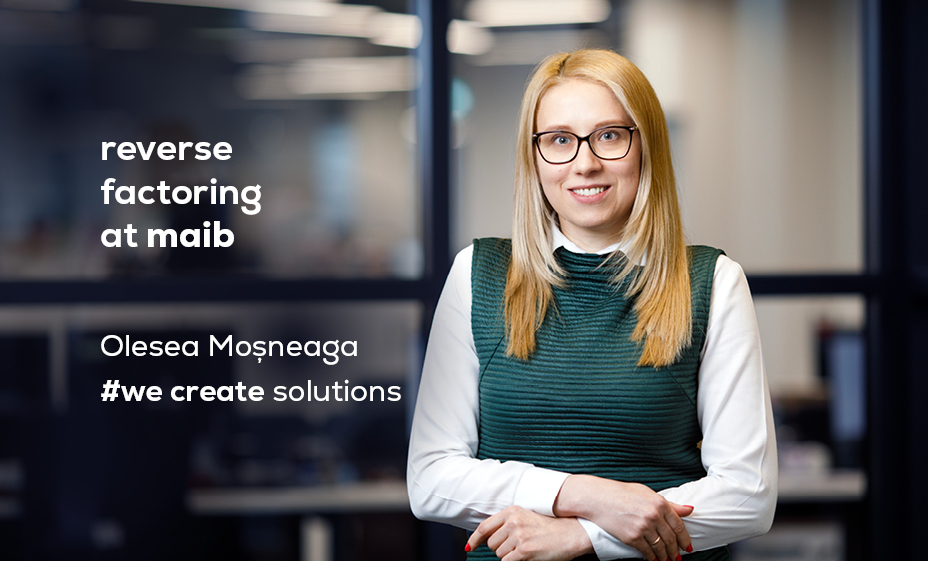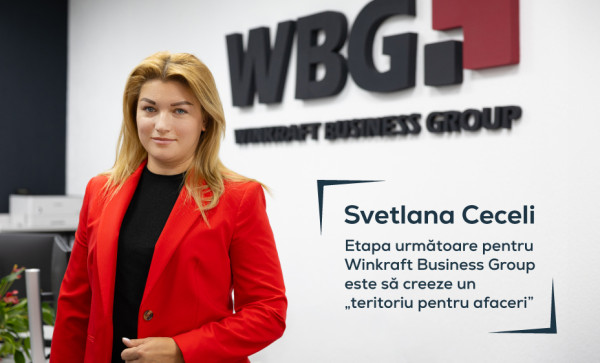Olesea Moșneaga, Head of the Documentary Transactions Group within the Corporate Support Orchestra at maib, in an interview with journalist Pavel Zingan.
Olesea, hello. At the end of last year, we discussed maib’s activity in financial services, such as factoring. Then, it was about "standard" factoring. Recently, maib also started offering Reverse Factoring services. Please define Reverse Factoring for readers so that the topic of our conversation is evident from the beginning.
"Standard" factoring, as you called it, is a financial service of the bank for suppliers of goods, when the bank, with a certain commission fee, "buys" the invoices from the supplier and then independently collects the funds from the buyer. On the other hand, Reverse Factoring is a similar relationship between supplier, buyer, and bank, but the factoring service is provided to the buyer, not the supplier.
In such a situation, does the buyer pay a commission to the bank?
Not necessarily. Charging of the commission fee is at the discretion of the parties, and the factoring commission fee can be withheld from both the buyer and the seller, depending on what has been stipulated in the factoring contract.
I've known about factoring for a long time but haven't heard about Reverse Factoring.
Factoring is still being developed in the Republic of Moldova and is at an early stage, especially compared to Romania. Analysing the Romanian experience, I have been paying attention to the statistics on Reverse Factoring, which we are now actively promoting and from which our customers can benefit. It is still difficult to collect such statistics for the Republic of Moldova because we do not have a factoring association collecting and studying market data.
Does it exist in Romania?
Yes, and it provides interesting statistics. Preparing for the interview, I was surprised by the level of development of the factoring market in Romania, which reached €8.66 billion in 2023. While the overall growth of the factoring market is 10% per year, reverse factoring is growing at 30%.
Let's assess the Reverse Factoring mechanism to understand the interest in reverse factoring in the Romanian market.
Let's take the example of a large grocery chain retailer. In standard factoring, everything starts with the seller, who issues an invoice. At the bank, we evaluate the seller, and they assign their debts to us in an invoice. We finance them, and then the debtor pays us the debt. In Reverse Factoring, the process starts with the debtor, who has to pay. For example, we have a seller who issues an invoice, the buyer pays it, and then maib comes in. Unlike standard factoring, where we evaluate and finance the seller, the buyer is our primary customer in Reverse Factoring.
This makes it much easier for small suppliers. Obviously, instead of evaluating dozens (hundreds) of companies, the bank only has to identify a major one.
Yes, Reverse Factoring is aimed at large debtors. We analyse such a customer, set a factoring limit, and conclude a contract. Then the customer establishes that it is prepared to work with certain suppliers through Reverse Factoring. We contact these suppliers and offer them Reverse Factoring, knowing the customer has already agreed.
And there is no need to review the supplier's activity?
That's right. The process has been simplified for the supplier. We sign a factoring agreement with them due to the assignment of the receivable, which is the legal base. The supplier delivers the goods and issues an invoice to the buyer, which is then sent to the bank. The bank pays the invoice, and the supplier receives the money immediately, whereas, in a "standard" contract with a network, payment can be scheduled over 60 or 90 days.
What is the commission fee?
It depends on how much was negotiated. We have a practice where the supplier pays the service fee, which is in the supplier's favour. The commission fee is small, but they get the money immediately. Otherwise, they would have waited 60 or 90 days. For example, Reverse Factoring became particularly popular in Romania during the COVID-19 pandemic. Small companies usually need more collateral and receive funding through large borrowers.
Reverse Factoring helps to strengthen partnerships. Both parties benefit: debtors get more favourable payment terms, and suppliers get immediate invoice financing.
In the future, we could discuss sharing the commission fee between the parties. This is already practised in other countries, and there are platforms for this.
Who initiates Reverse Factoring more often: the borrower, the supplier or the bank?
As a bank, we promote this service and engage in our customers' financial education. I'm glad that customers have started using factoring more often and are getting used to this type of financing. Customers themselves choose to go for standard factoring or Reverse Factoring.
When did maib start offering Reverse Factoring services?
Recently, the first transactions were made in March.
For what industries do you think Reverse Factoring is suitable?
I think retail business is the main industry. Next are manufacturers and telecom companies, but it can also be road construction, where the ecosystem of large debtors needs multiple suppliers.
Is there a limit on the factoring amount?
The minimum factoring amount is 50 thousand MDL. On maib.md, a calculator allows customers to calculate the commission fee amount to decide whether factoring is convenient.
Do you anticipate that Reverse Factoring will increase in Moldova?
Yes. We follow the principle of "Projecting the debtor's credit rating onto the supplier," which allows the debtor, as a partner, to help its valuable suppliers, even if their financial situation does not allow them to apply for factoring directly to the bank. We also offer all suppliers involved in the Reverse Factoring service an accelerated flow of funds and time savings. It's a typical win-win situation.


 maibank
maibank
 maib business app
maib business app
 online loans – legal entities
online loans – legal entities
 internet banking - individuals
internet banking - individuals
 new internet banking - maib business
new internet banking - maib business
 internet Banking - BankFlex
internet Banking - BankFlex




